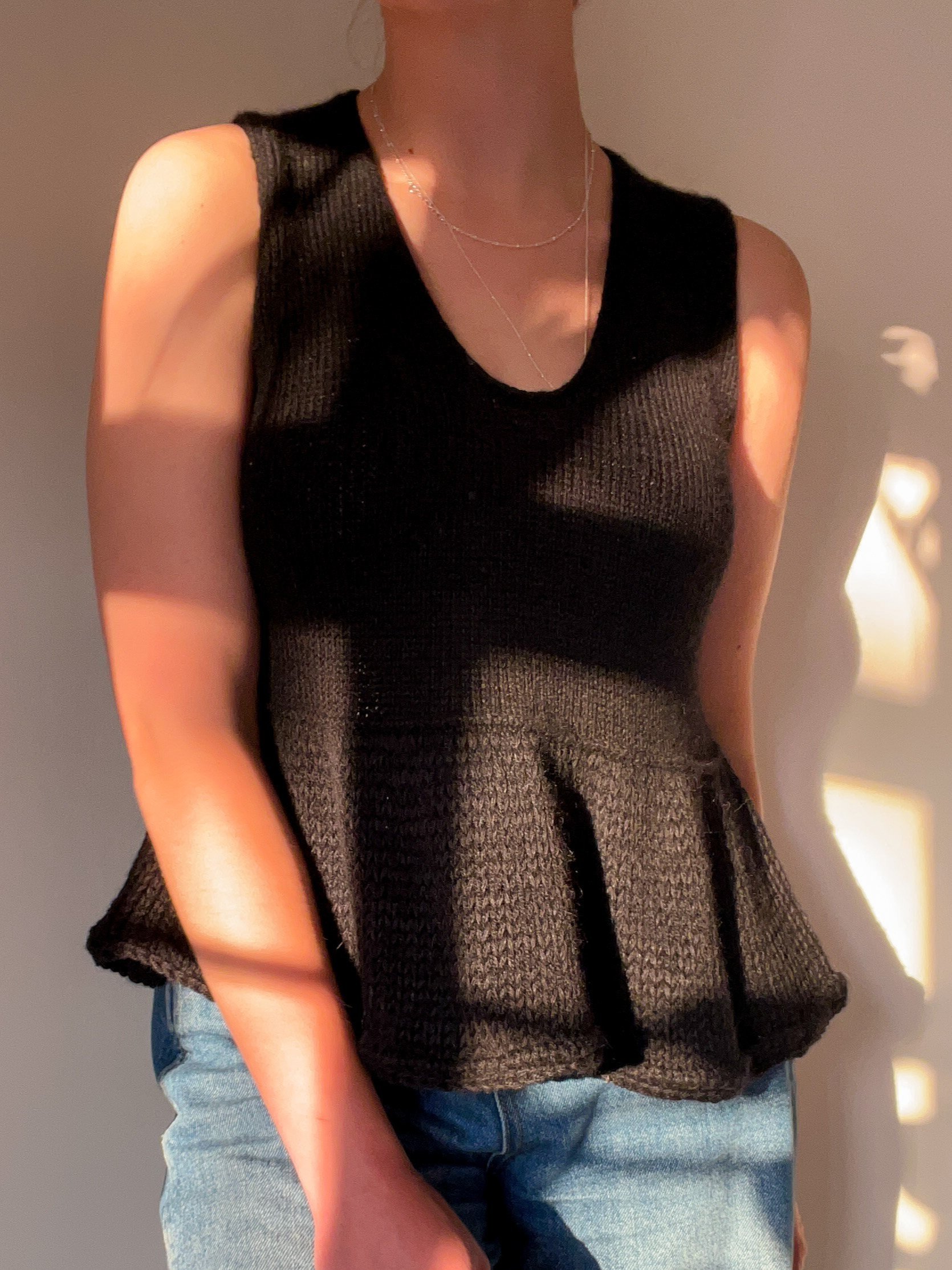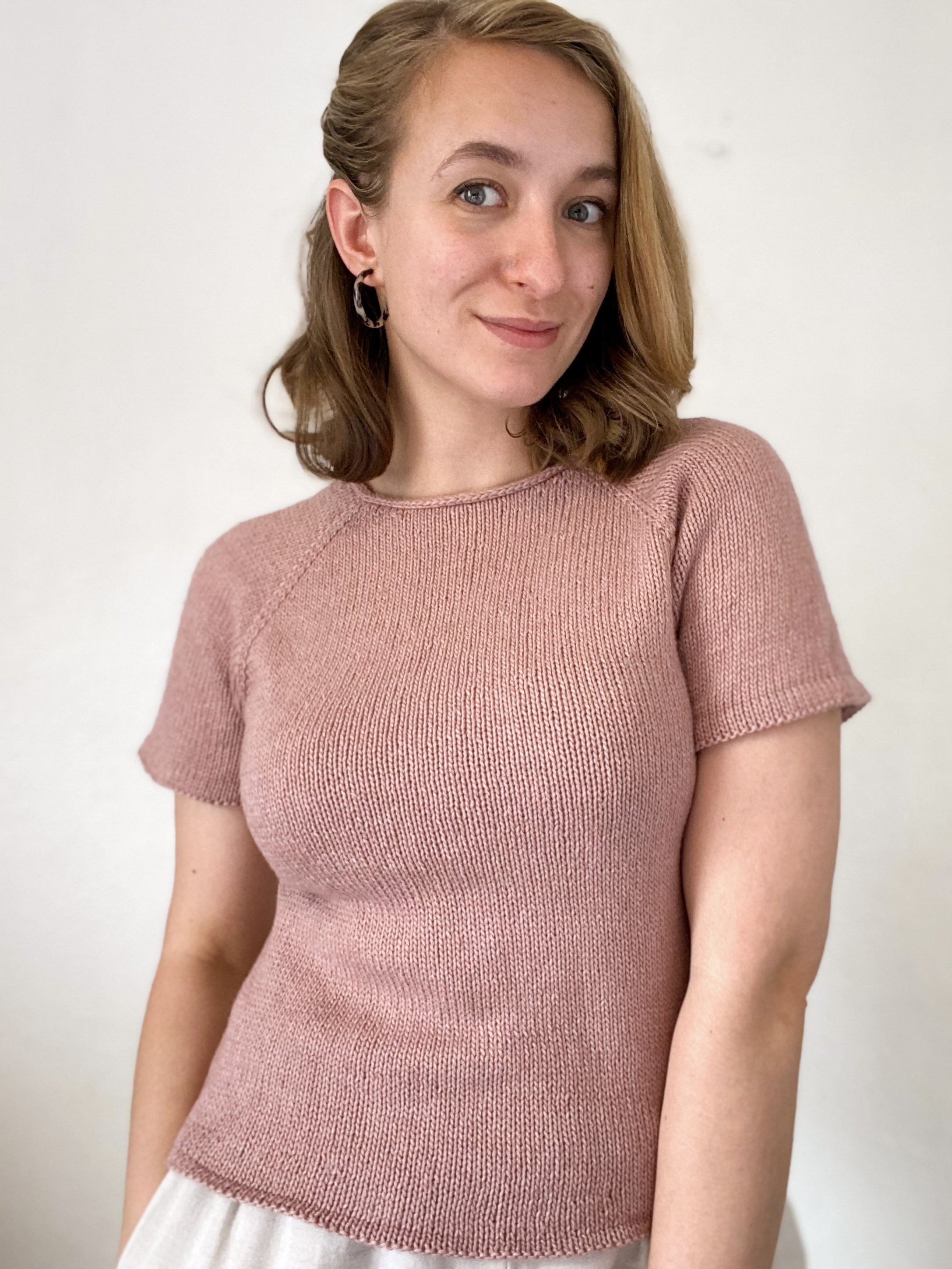Peplos Top
The Peplos Top is a summer-ready camisole, with cording stitch details, optional waist shaping and a peplum. It has a high back and thick straps, which makes it both comfortable to wear and – most importantly – bra-friendly.
You will begin by working the back panel, with optional short-row shaping at the shoulders, down to the underarms. Once you have finished the back underarm shaping, you will pick up and knit stitches to form the left shoulder and then the right shoulder down to the underarms. After this, you will join the panels together with some underarm and centre-front stitches and begin working in the round.
You will then have the option of working waist shaping, before working some cording stitch. After that, you will change to a larger needle size, add additional strands of yarn, and work a peplum which is, again, finished with cording stitch details (see black sample). There is also an option to omit the peplum and to work the full length of the cami at the smaller gauge with a more fitted look (see off-white sample). To finish, you will apply i-cord to the armholes and neckline.
The Peplos Top is a summer-ready camisole, with cording stitch details, optional waist shaping and a peplum. It has a high back and thick straps, which makes it both comfortable to wear and – most importantly – bra-friendly.
You will begin by working the back panel, with optional short-row shaping at the shoulders, down to the underarms. Once you have finished the back underarm shaping, you will pick up and knit stitches to form the left shoulder and then the right shoulder down to the underarms. After this, you will join the panels together with some underarm and centre-front stitches and begin working in the round.
You will then have the option of working waist shaping, before working some cording stitch. After that, you will change to a larger needle size, add additional strands of yarn, and work a peplum which is, again, finished with cording stitch details (see black sample). There is also an option to omit the peplum and to work the full length of the cami at the smaller gauge with a more fitted look (see off-white sample). To finish, you will apply i-cord to the armholes and neckline.
The Peplos Top is a summer-ready camisole, with cording stitch details, optional waist shaping and a peplum. It has a high back and thick straps, which makes it both comfortable to wear and – most importantly – bra-friendly.
You will begin by working the back panel, with optional short-row shaping at the shoulders, down to the underarms. Once you have finished the back underarm shaping, you will pick up and knit stitches to form the left shoulder and then the right shoulder down to the underarms. After this, you will join the panels together with some underarm and centre-front stitches and begin working in the round.
You will then have the option of working waist shaping, before working some cording stitch. After that, you will change to a larger needle size, add additional strands of yarn, and work a peplum which is, again, finished with cording stitch details (see black sample). There is also an option to omit the peplum and to work the full length of the cami at the smaller gauge with a more fitted look (see off-white sample). To finish, you will apply i-cord to the armholes and neckline.
Materials & Fit
Notions: 3.5 mm US 4nd/or 60-cm / 16- and/or 24-in cord), 4.5 mm / US 7 (80-, and/or 100-cm / 32-, and/or 40-in cord), and 9 mm / US 13 (80-, and/or 100-cm / 32-, and/or 40-in cord circular needles.
You will also need some stitch markers, at least 2 of which should be clip-on markers, a darning needle, and some spare needles, scrap yarn, or stitch holders. You may also wish to use some shirring elastic to cinch in the waist of the garment, but this is totally optional. Some test knitters did this to great effect.
Tension 1: 21 stitches x 27 rows = 10 cm / 4 in Stockinette stitch on 4.5 mm / US 7 needles, with 1 strand of each yarn held together (2 strands total).
Tension 2: 13 stitches x 14 rows = 10 cm / 4 in Stockinette stitch on 9 mm / US 13 needles, with 2 strands of each yarn held together (4 strands total).
Make sure to wash and block your swatch(es) for the most accurate results. Please note that I have tighter-than-average row gauge, but this isn’t too important in this pattern. You may wish to go up or down a needle size, working in 0.25/0.5 mm / 0.5/1 US needle size increments as needed to meet gauge.
Yarn: Approximately 2 (3) 3 (3), 3 (4) 4 (4), 4 (5) 5 (5-6) hanks of Isager Alpaca 2 (250 m / 274 yds = 50 g; 50% alpaca, 50% merino wool) held together with 3 (3) 3-4 (4), 5 (5-6) 6 (6), 6 (6) 7 (8) balls of Isager Bomulin (210 m / 230 yds = 50 g; 65% cotton and 35% linen; see off-white sample) or 3 (3-4) 4 (4), 5 (6) 6 (6), 6 (7) 7 (8) balls of Isager Trio (175 m / 192 yds = 50 g; 50% linen, 30% cotton, 20% lyocell; see black sample).
I estimate that you will need approximately 500 (550) 650 (700), 750 (850) 900 (950), 1000 (1100) 1150 (1300) m / 547 (601) 711 (766), 820 (930) 984 (1,039), 1,094 (1,203) 1,258 (1,422) yds] of each yarn if you are working with multiple strands of finer yarns, or of a single strand if you are working with a thicker yarn. These estimates are based on tester feedback and are, if anything, generous. If you do not want to work the peplum, you’ll need slightly less yarn.
Any combination of light fingering-weight yarns should work well. Where possible, I would recommend mixing animal- and plant-based fibres. This should produce a fabric with a good amount of drape and which feels cool in warm weather, but which still has some elasticity in the stitches. I found that I used slightly more of the Trio 2 yarn than Alpaca 2 or Bomulin. I think this is due to the difference in elasticity between the two fibres, so I would keep this in mind if you are wanting to use yarns with little-to-no elasticity.
For the first sample garment (black, with a peplum), I used Isager Alpaca 2 in the shade 30 held together with Isager Trio 2 in the shade Ink. For the second sample (off-white, no peplum), I used Isager Alpaca 2 in the shade E0 held together with Isager Bomulin in the shade 0.
Sizing and ease: The Peplos Top has about 0-5 cm / 0-2 in neutral-to-negative ease for Sizes A-H, and between 5 cm / 2 in positive ease and 5 cm /2 in negative ease for Sizes I-L around the chest. If you would prefer more ease, pick a size up. If you would prefer less ease, pick a size down. The sample garments are both Size D to fit a 92-cm / 36.25-in chest. Use the schematic below to find your best size based on your chest measurement. Please keep in mind that there is optional waist shaping, too, with detailed notes within the pattern itself.
Size: A (B) C (D), E (F) G (H), I (J) K (L)
Chest measurement (cm): 75-80 (80-85) 85-90 (90-95), 95-100, (100-105) 105-110 (110-115), 115-125 (125-135) 135-145 (145-155)
Chest measurement (in): 29.5-31.5 (31.5-33.5) 33.5-35.5 (35.5-37.5), 37.5-39.25 (39.25-41.25) 41.25-43.25 (43.25-45.25), 45.25-49.25 (49.25-53.25) 53.25-57 (57-61)
Actual circumference of garment at chest (cm): 75 (81) 85.5 (90.5), 95 (101) 105.5 (110.5), 121 (130) 141 (150.5)
Actual circumference of garment at chest (in): 29.5 (31.75) 33.75 (35.5), 37.5 (39.75) 41.5 (43.5), 47.5 (51.25) 55.5 (59.25)
Armhole depth and depth of neckline (cm): 19.5 (19.5) 20 (20.5), 20.75 (21.25) 21.5 (22), 22.75 (23.75) 24.5 (28/25 respectively)
Armhole depth and depth of neckline (in): 7.5 (7.5) 7.75 (8), 8.25 (8.25) 8.5 (8.75), 9 (9.25) 9.5 (11/9.75 respectively)
Total length (cm): 49 (51) 55 (57), 59 (61) 63 (64), 65 (67) 69 (71)
Total length (in): 19.25 (20) 21.5 (22.5), 23.25 (24) 24.75 (25.25), 25.5 (26.25) 27 (28)
Techniques include German short rows (optional), working flat and in the round, casting on stitches to join panels, cording stitch, picking up stitches along horizontal and vertical edges, and working an applied i-cord trim.















